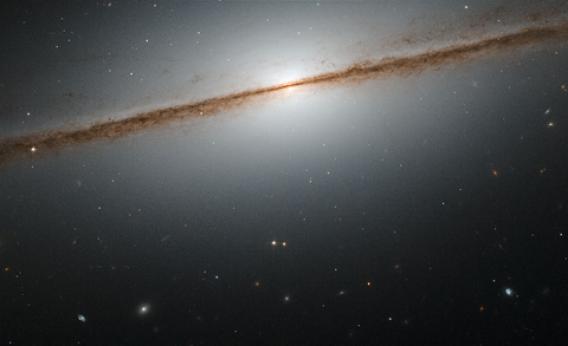Create a free profile to get unlimited access to exclusive videos, sweepstakes, and more!
Taking a Dusty View

I do love an edge-on spiral galaxy. They look so odd!
That image above is from the Hubble Space Telescope and shows NGC 7814, a galaxy about 40 million light-years away. That makes it relatively close as galaxies go! It’s a bit like looking at a house in the next town over. Not really your neighborhood, but not a long haul, either.
The glow you see is the combined light from countless billions of stars, for the most part orbiting the center of the galaxy in a flat disk. It’s not perfectly flat, obviously; you can see it’s puffed up a bit toward the center. That’s normal for spirals; they tend to have a bulge in the middle. Don’t we all.
The dark stuff is what astronomers call dust; complex molecules loaded with carbon. If you like technical terms, it’s also called polycyclic aromatic hydrocarbon. So there you go.
Dust is created when stars are born and when they die; it gets strewn through the flat disk of a spiral, but is also clumped up in knots and filigrees in giant nebulae, clouds that are stellar nurseries.
Dust is opaque, blocking starlight behind it, so when you see a galaxy like this edge on you see it as a thin line bifurcating the galaxy’s equator. NGC 7814 is a fine example of it.
When I see galaxies like this, I sometimes wonder what they would look like if we could see them from a different angle. That’s not possible; we’d have to travel millions of light-years (quintillions of kilometers!) to change our perspective. But … sometimes nature provides. There are, after all, a lot of galaxies in the sky, tipped at all different angles. Finding one that gives us a better angle isn’t that hard.
That’s NGC 6861, also as seen by Hubble. It’s a galaxy similar to NGC 7814, but obviously tipped to our line of sight. Here you can see the dust swirling around the center, as well as the glow of stars. It looks like a spiral, but in fact NGC 6861 is what’s called a lenticular (lens-shaped) galaxy, a sort-of hybrid between a spiral and elliptical galaxy. It has features of both, and may be the result of a collision between two midsize galaxies. NGC 6861 is in a small, tight group of galaxies, so a collision and merger between two of them isn’t far-fetched.
I love the picture; it looks like a flying saucer whizzing by. And it shows an effect I really love: See how the dust looks darker on one side than the other? The galaxy is relatively flat, and we see the dust on the near side (upper left) fairly directly. But there are lots of stars in the galaxy, and we look through them to see the far side; they’re between us and the far side, so we see their glow. This “fills in” the dark dust, making it look somewhat faded compared with the dust on the galaxy’s near side.
This is a pretty common phenomenon in slightly tilted disk galaxies; check out NGC 3521, NGC 7049, and NGC 2841 (seriously: Click those links. The images are spectacular).
In a lot of objects it can be pretty hard to tell which side is which, but in these cases a little thought shows the way. Studying galaxies is a funny occupation. You can spend a lot of time learning all about one in particular, but you’re stuck with the way it appears. You can’t go there or change your perspective. But you can learn so much more by studying some of the thousands of other galaxies in the sky, comparing and contrasting.
And of course, they teach us about our own galaxy, the Milky Way. After all, we live in its disk, so we see it edge on as well, even as we’re embedded in it. That makes it both the easiest and hardest galaxy to study; we can see it up close, but it’s maddeningly difficult to understand it as a whole. By studying other galaxies, separated from us by such unimaginable gulfs, we wind up getting a better grasp of, quite literally, where we live.


























